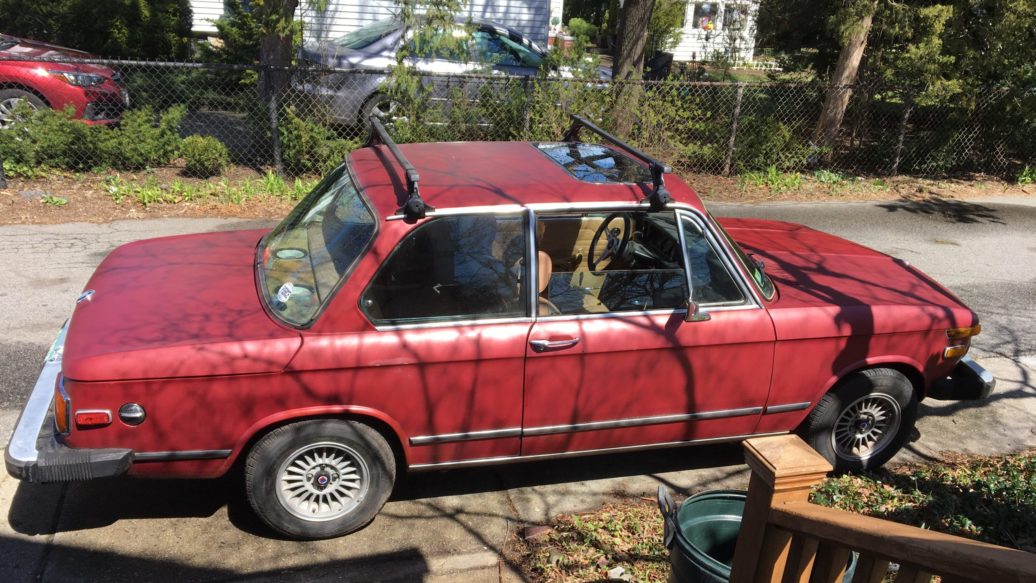Last week, a 1976 2002 I immediately christened Carter (due to the original campaign sticker on the rear bumper) fell into my lap for an asking price that made me drop everything, look at it, and buy it on the spot. On the negative side, it had been sitting for nine months and was filthy inside and out—the rear floor held two inches of water, likely caused by a leak in an unfortunate aftermarket sunroof—but that deficit was countered by its reportedly being a California car until six years ago, with rust-abatement work that appeared to render it largely rust-free, and it started easily with a fresh battery and a goose of starting fluid.
Oh, and it was wearing a set of original 13×6″ Alpina wheels.
The timing of the purchase was almost comical, since just a week earlier I’d submitted a piece to Hagerty titled “Why do we buy the same car over and over?” whose cover photo showed me standing with three 2002s. Hey, when it makes sense, it makes sense.
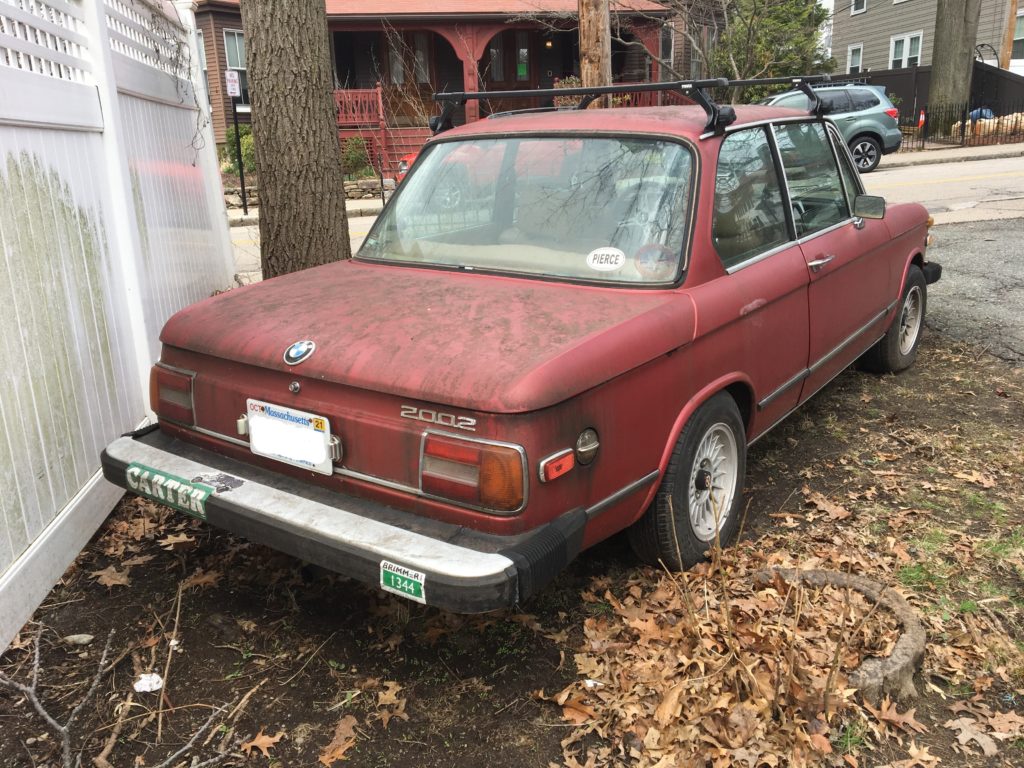
Carter, in all his sitting-for-nine-months magnificence.
After handing over the money in exchange for the title and a bill of sale, my immediate task was to get Carter home. The seller said that I could leave the car where it was until the end of April, but a tight upcoming travel schedule made me realize that I had little time—and even less space. My driveway was still completely filled with the cars that I’d moved out of their storage space in Fitchburg and hadn’t yet transported to their new digs on the Connecticut border. As I discussed here (but didn’t say why), a group of us—my wife, Maire Anne, two friends, and I—hastily shuttled three of the four cars out to Monson (the M coupe is still at the house). That freed up driveway space for Carter.
So, drive it home? Well….
When I bought the car, I had not actually driven it, unless you call moving it three feet in the seller’s driveway driving it. There were a number of reasons for this seemingly odd choice: The first was that although the owner said the car was registered and insured, the license and inspection tags were out of date, and the combination of expired tags, the leafy suburb of Brookline where the car was, and the fact that after nine months of sitting the car looked like Beatrix Kiddo when she crawled out of her own freshly-dug grave in Kill Bill Part II made me feel that the odds of getting stopped and ticketed were high.
The second reason was that I had just assumed I’d tow the car home (after all, if I don’t use my beast of a formerly mouse-infested truck to tow cars, I’m not sure why I own it), and felt that moving it three feet was all I needed to do to assure myself I could put it out on the street where it could be easily accessed. The third was that I really didn’t want the two inches of water on the back floor to slosh forward during a test drive.
But perhaps the primary reason I didn’t drive it was that I didn’t feel it was necessary. I’d already made the “buy” decision based on price, lack of rust, a running engine, and lack of oil smoke; any necessary sort-out issues I discovered while driving it were highly unlikely to alter that choice.
Carter’s previous owner had told me that the car ran great before he parked it for nine months. He’d been accurate and truthful in everything else he told me, including his prediction that the car would snap to attention with a fresh battery. Although I could easily tow the car home myself, or use my Hagerty or AAA towing benefit, the idea of driving it the eight miles from Brookline back to my house began to seem like a natural, as well as a much better ending to the story of the purchase. I mean, I’m about to go to MidAmerica 02Fest and spend a weekend rubbing giubos with a hundred other 2002 owners. I didn’t want to be greeted by angry protesters with signs saying HACK MECHANIC NOT WELCOME! HE DIDN’T HAVE THE STONES TO DRIVE A RUNNING 2002 EIGHT MILES HOME! Thirty-year-old me would’ve done this in a heartbeat. Nine months isn’t that long for a car to sit, and eight miles on local roads isn’t that far to drive, even if the Alpinas were wearing badly dry-rotted tires. So I elected to drive it.
I called Hagerty and added the car to my policy, and they emailed me the Massachusetts Registration and Title Application (RTA) form with the insurance stamp on it. I hadn’t yet gone to the registry to get plates, but I figured that with the RTA form and the seller’s plates still on the car, I was close enough that if I was stopped, I had a plausible explanation.
Still, when there’s any doubt about legality, these things are best done under cover of darkness.
At sunset, I had Maire Anne shuttle me over to Brookline in my E39. In the trunk was a modicum of tools, a battery, a compact cigarette-lighter-powered air compressor to inflate the tires (they were clearly low), and some things that I’ve never brought with me as part of my limp-a-car-home arsenal: a portable sump pump, a short length of garden hose, and an inverter. My idea was to drop in the battery, plug the inverter into the cigarette lighter, plug the portable sump pump into the inverter, and use it to drain all that nasty water from the back floor. I really didn’t want it sloshing forward onto the front floor the first time I hit the brakes. The video of this surprisingly effective bit of Rube Goldberg-channeling can be seen here.
I was about to inflate the tires, but I checked them with a gauge and found that they were all in the low 20-PSI range. Since the little compressor takes forever to pump things up, I figured that this was good enough for an eight-mile crawl at 30 mph. So, with the floor no longer covered with enough water to drown a sleeping wino, I eased the car out of the driveway and onto a Brookline side street, and began heading west to Newton.
It was immediately obvious that this was a bad idea.
First, the headlights went out. I had to hold the stalk in the high-beam flasher position to get them back on. I pulled over. Fortunately, repeated pulling of the headlight switch in and out revived the lights, so the cause was likely poor contacts in the switch.
Next, what had been a smooth-idling engine underwent a dramatic personality change. When it was under load, it ran like eight bags of crap; it seemed way down on power, and when pushed over 2,500 rpm, there was so much clattering from the engine compartment that I wondered if I was hearing a rod knock. As I said last week, while I was enchanted with the idea of using the car for an M20 engine swap, I didn’t want my hand to be forced before I even got the car home.
And the suspension and steering felt horrible, with clunking from the back and so much banging from the right front that I worried the car might have a bad ball joint. Add the under-inflated tires, and I felt like I was driving through sand while occasionally running over an anchor.
To top it off, after only a few blocks, I made a wrong turn, Maire Anne got caught at a red light, and I completely lost her. I pulled over and called her on my cell phone, but she didn’t answer. I waited, but didn’t see her. Finally I shrugged and set off homeward. I did the “Siri, message Maire Anne” thing and gave voice-to-text updates telling her where I was every five minutes, but it completely sank the plan of having her follow me home in case I needed assistance.
However, the car and I did make it home; the wheezing, sputtering, thunking, and clunking Carter limped into the driveway of my house in Newton perhaps twenty stressful minutes later. The idea that I’d gotten Carter at half to a third of its market value was rapidly evaporating, and I wondered at the wisdom of what I’d just bought as well as my choice of self-delivery. On the other hand, part of me had to laugh that, at age 63, I still have the ability to do something so stupid.
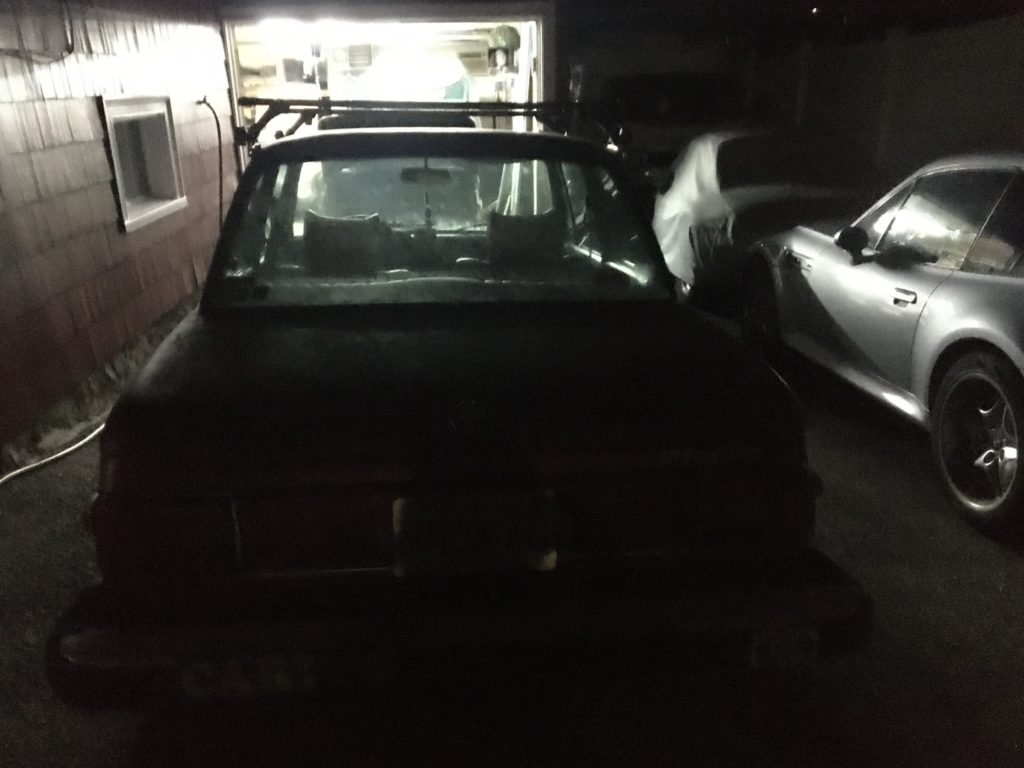
Carter joins the M coupe and the under-cover Z3.
There was something bigger going on, however: Carter was the first car I’d bought since before the pandemic. My previous purchase was the triple-unicorn X5 two-and-a-half years ago. )Yeah, I know; there are some caveats that must accompany that statement. I also bought back Zelda the Z3, but since I’d owned her before, that hardly counts. And I bought the mouse-infested truck, but, well, it’s a truck, so that hardly counts.) I’d courted several other enthusiast vehicles, but none of them came to fruition. So having something new in the driveway was, uh, well, something new. And very welcome.
There’s a real rush that comes from having a new project. Some of it is, as Bobby Rahal said in Roundel decades ago, “the Fresh-Rattle Syndrome,” from tiring of the rattles in your existing car and wanting a fresh one. But there’s another dynamic at work, something I never thought about until I tried to articulate it.
There are few automotive experiences as exciting and satisfying as those first few days or weeks you have with a new project, and the reason is this: It’s the window in which you can make the most dramatic changes to a car.
No? Don’t believe me? Think about it like this. It’s not easy to change the condition of the body of a car; bodywork and paint are incredibly expensive and time-consuming. If a car’s got rust, or if the exterior is dented and the paint looks like hell, no magic wand is going to make it go away quickly. Likewise, if there are drivetrain issues—if the engine has low compression, or burns oil, or if the clutch slips, or the transmission crunches synchros—those are not quick and easy repairs. And if the interior looks like a bomb went off inside, with torn seats and a hanging headliner, it takes a lot of time and money to set it right.
However, if a car is merely neglected, you can usually make dramatic strides in appearance, function, and performance by addressing the first layer of the onion. With a little cleaning, attention to the ignition and fuel-delivery systems, maybe brake pads or a shock or bushing replacement, you can often, in days or weeks, move the car to another level. Nowhere else in the lifetime of ownership can you move the needle so far so quickly. For this reason, I find this first rush of project ownership intoxicatingly satisfying.
The morning after Carter crawled into my driveway, I washed it during a light rain. The first layer of grime came off. In the photos below, the car looks astonishingly good, but most of the shine you’re seeing is water, not paint. Still, it was a dramatic improvement.
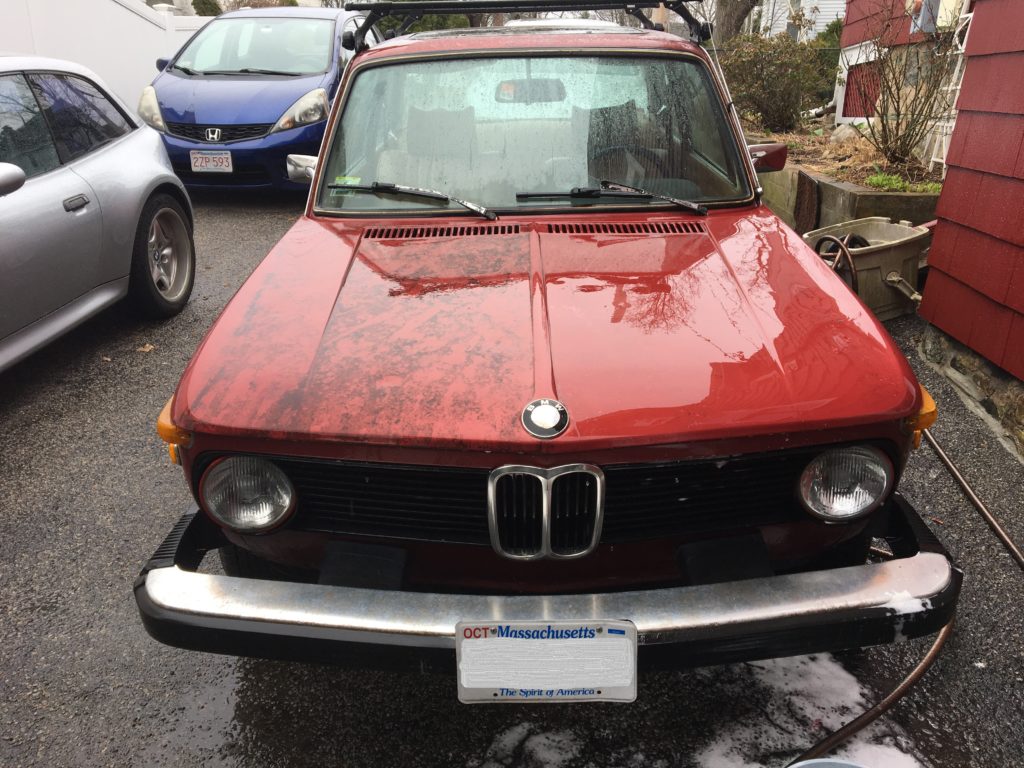
Thirty minutes with a wash mitt and a bucket…
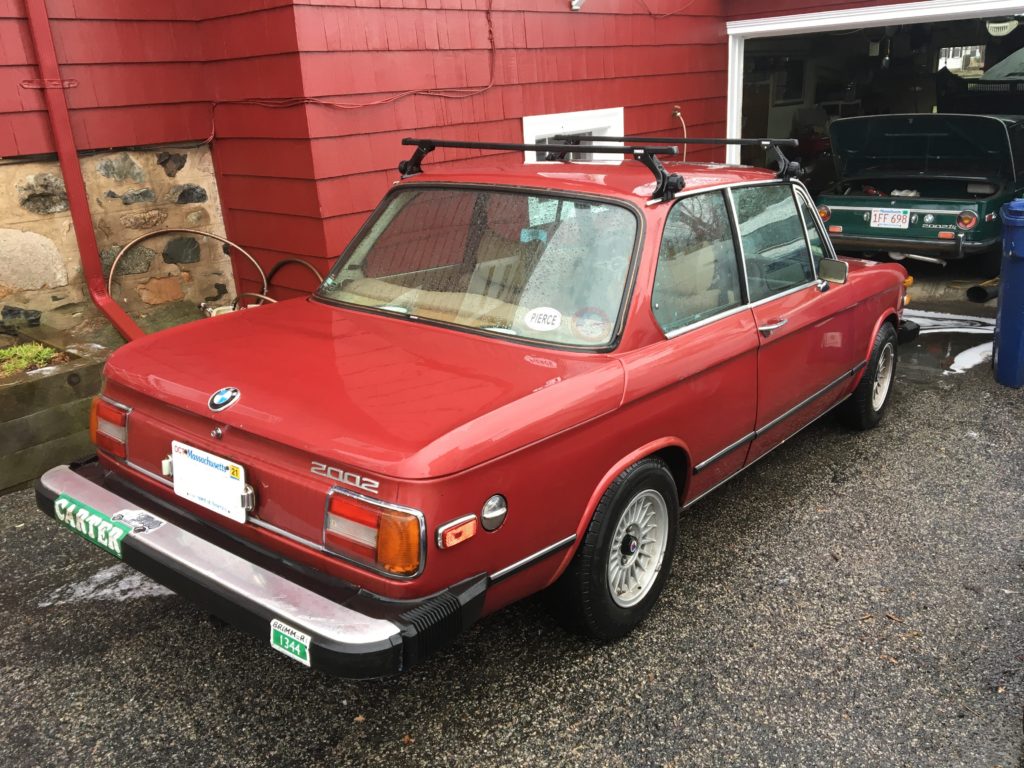
…and voilà! Again, much of what you’re seeing is wetness, not shine, but still, I was thrilled.
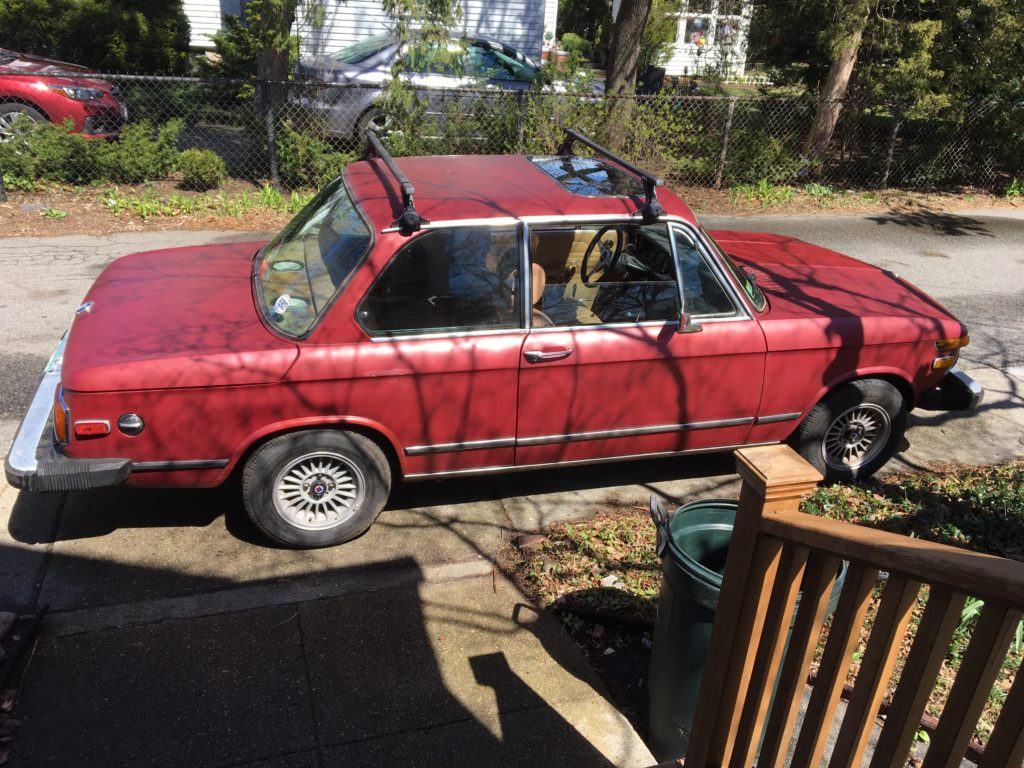
This is a better representation of what the Granatrot paint looks like in the sun. Another washing followed by careful compounding should make it pop quite a bit more.
Next, when it stopped raining, I gave the interior a quick cleaning. I threw out the trash, vacuumed up the leaves and dirt, used a chamois to soak up the remainder of the water in the rug, and then ran a fan overnight to dry it out. I left the car wide open in the sun for a day, then closed it up with my ozone generator running in it for a few hours. In the morning, the wet smell from the soaked rug was gone.
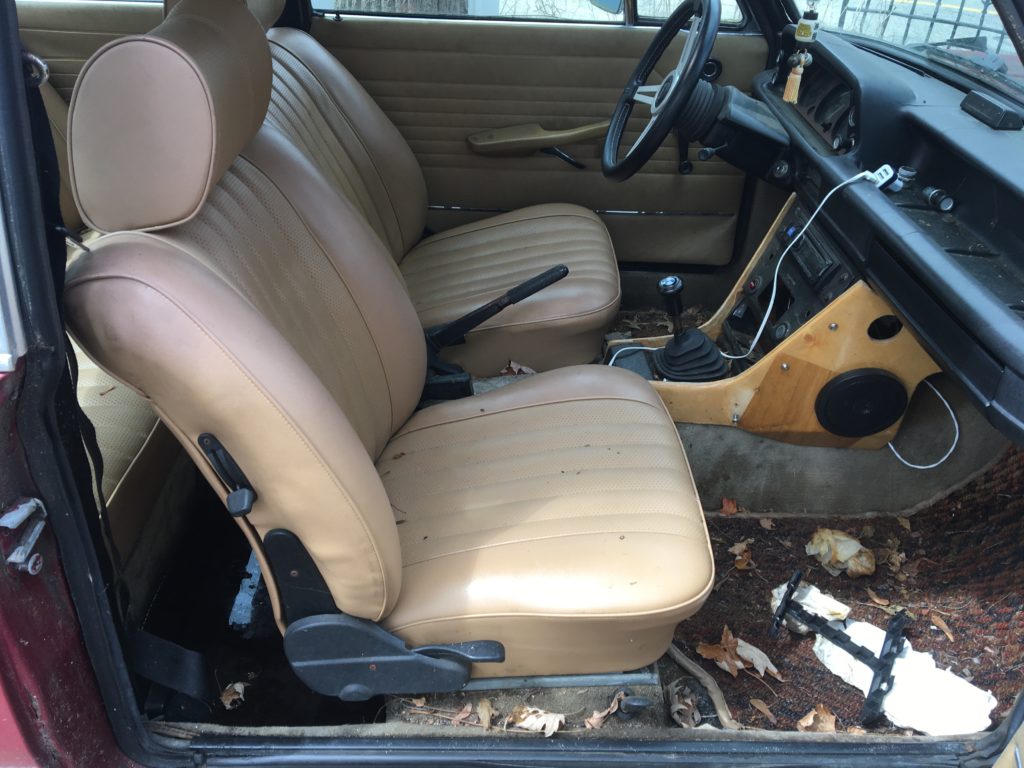
This…

…changed to this. I do need to paint those home-made speaker-hosting console side panels flat black.
Next was the issue of all the clatter from the engine. The following morning, with the engine dead cold, I adjusted the valves. I didn’t really think that they were the root cause of all the clatter, since loose or worn rockers tend to be loud all the time, but it’s a bonding step that I love to perform with a newly acquired car. A few valve eccentrics were a little loose, but nothing was out of the ordinary. And the valve train wore a nice brown patina, not the black head-never-been-off-the-car that I found when I pulled my 2002tii’s head at the start of the winter.
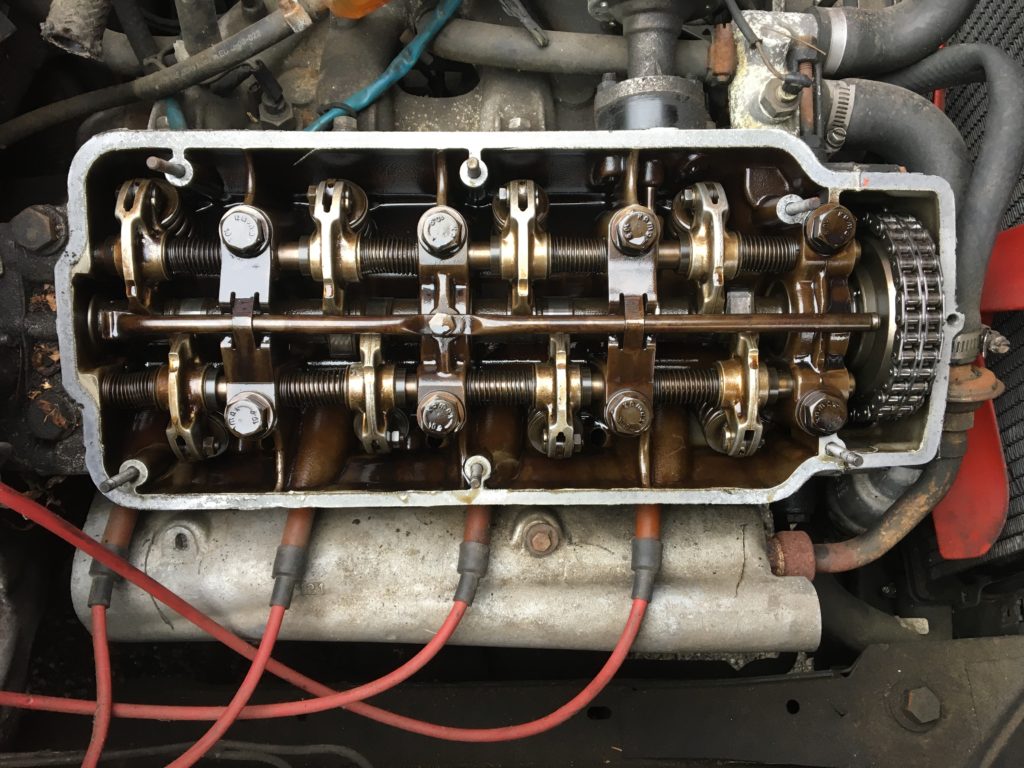
This looked just as it should.
I ran down to the registry and plated the car. With Carter fully legal, I inflated the dry-rotted tires and ran it once around the block. For reasons unknown, it ran better than it did when I drove it home, but there was still an awful metallic clatter that rose to a crescendo at around 2,500 rpm.
I found that a good portion of the noise was from the unused clamping bracket for the battery. I then poked around with a mechanic’s stethoscope and found that much of the remaining noise was due to a loose bolt attaching the unused smog pump to its bracket, and the exhaust heat shield not being fully secured due to a snapped-off bolt that once held it to the manifold. With the former tightened and the latter removed, only a small amount of clatter from the timing chain could be heard on the stethoscope. Another drive around the block verified that my feeling that the engine was going to fly apart was gone.
The next layer of the onion was the suspension. I first looked at the banging sound from the right front. I jacked up the car, set it on stands, and examined the steering components, squeezing the ball joints with a big pair of slip-joint pliers to check for play: They were fine. I set the car back down, bounced the front right corner, and immediately heard it banging. I was able to localize it to the right front strut tower bushing. If you have the right kind of spring compressor, it’s possible to replace these bushings in situ without removing the strut assembly from the car. When I removed the old bushing, it was clear that the bearing assembly inside had gone bad. I replaced the bushing with a good used one I had in the garage. The banging noise was gone.
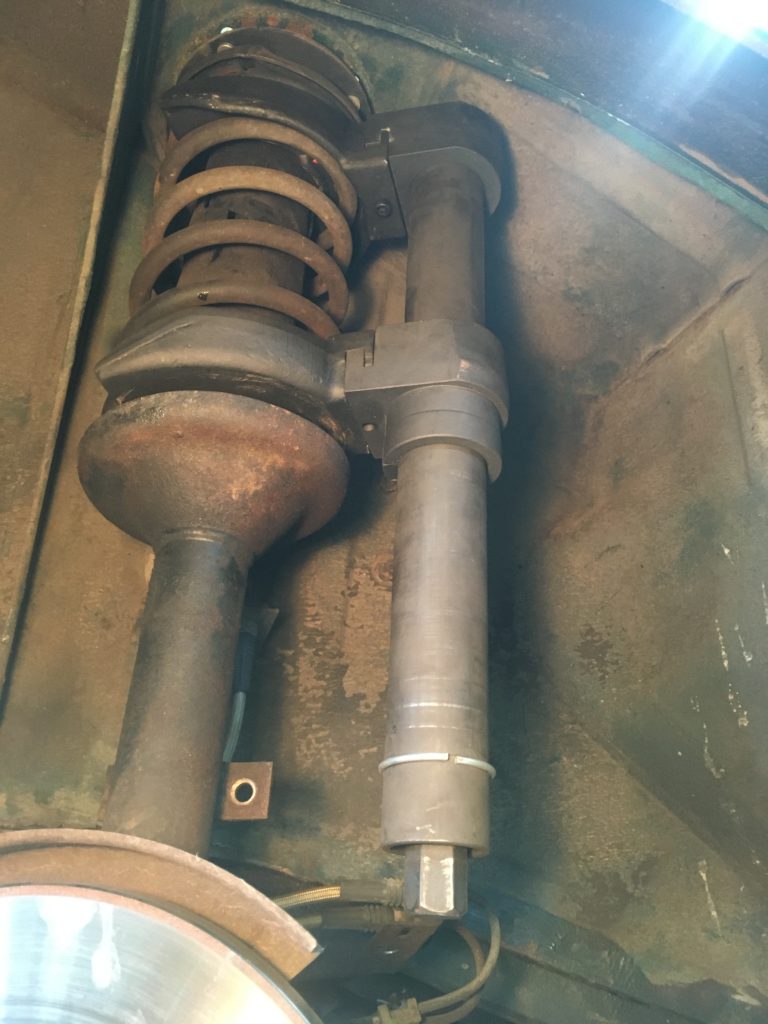
This photo is actually from Louie the 2002tii, not Carter, but it shows how, with a plate-style compressor, it’s possible to compress the spring and replace the bushing in situ.
Next I bounced the rear of the car up and down (one of the few good things about those ridiculously large bumpers) and reproduced the thunking sound I heard while driving. I opened the trunk and did it again, and could see the tops of the shocks moving around due to the rubber mounts being worn out. I replaced them with a new unused pair I had in the garage, and the noise went away completely.
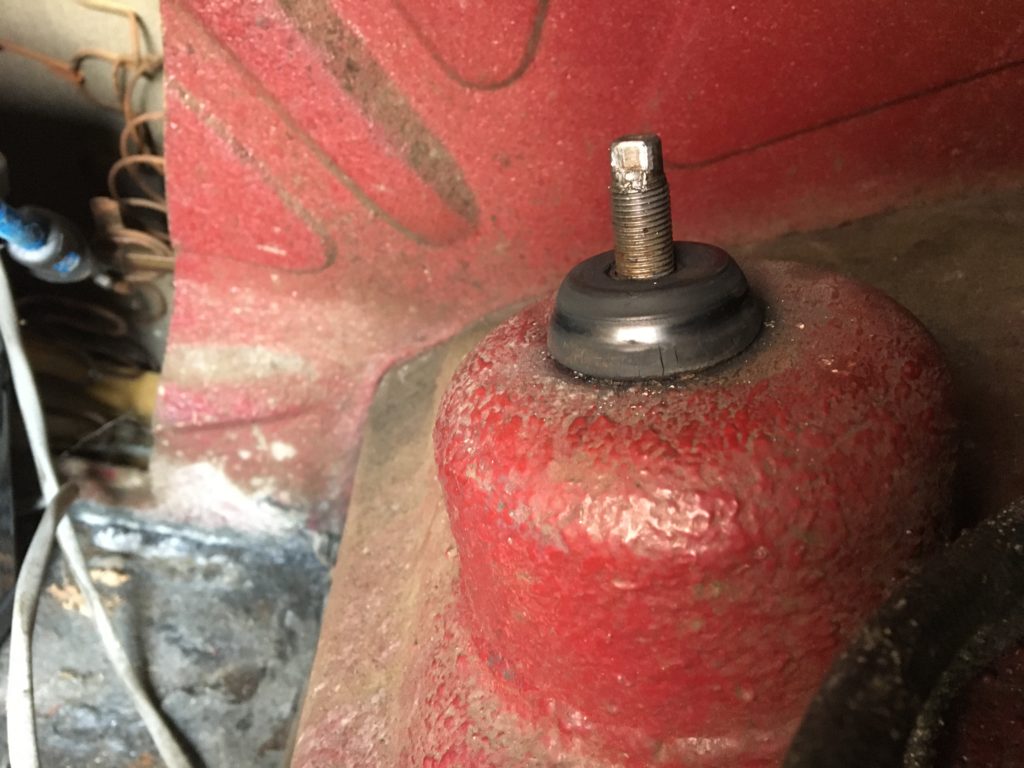
These were bad, and easily replaced.
And with that, I needed to stop, as a vacation with Maire Anne in Santa Fe visiting our middle son, immediately followed by the trip to MidAmerica 02Fest, were both barreling toward me. When I’m back in early May, the next thing on my agenda will be to get some new tires on those Alpinas; running around the block on dry-rotted garbage is one thing, but taking the car out on the highway that way is unnecessarily risky.
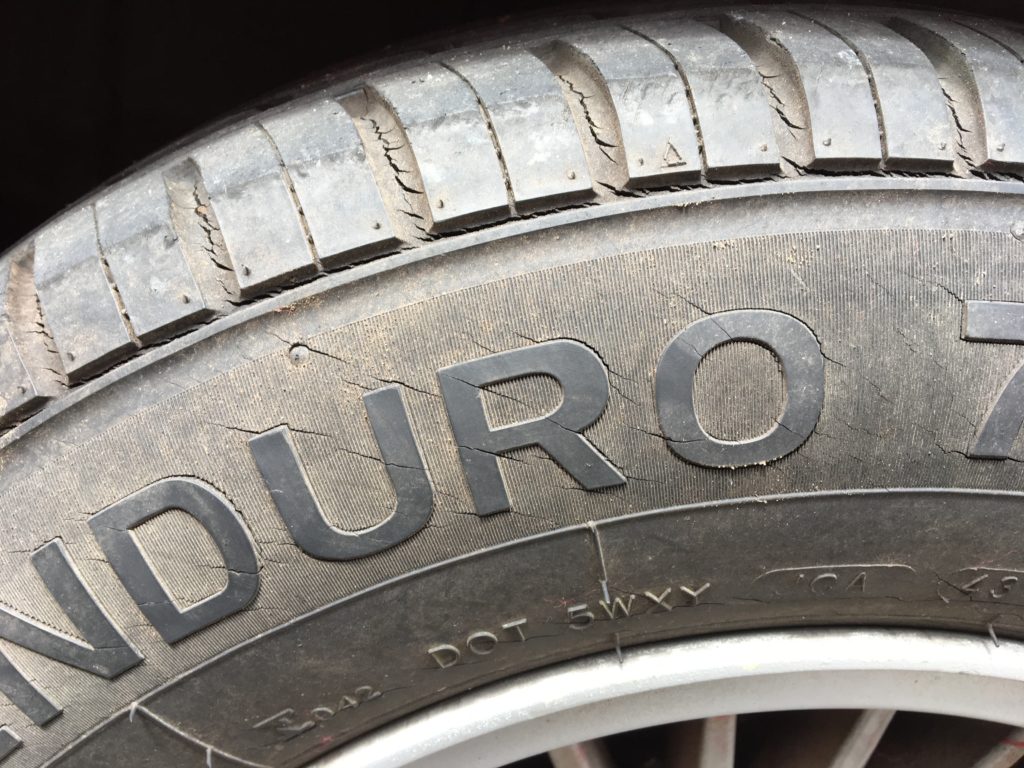
Yeesh, right?
From the “getting to know you” standpoint, there are still a few mysteries. When I first walked around the car, I thought that the center-exit tailpipe pegged it as a ’75. However, the VIN clearly puts it as a late ’76, and that jibes with the partially-desmogged engine compartment that holds the disconnected smog pump and the still-connected EGR plumbing, but no thermal reactor integrated with the exhaust manifold. But the head is stamped E12, not E21, as I’d expect of a ’76. I haven’t yet checked the VIN on the block to see if it’s the original engine.
The water on the back floor is still a mystery, because I haven’t seen any water leaking through the sunroof. And I still haven’t given the undercarriage a thorough inspection to see exactly what evidence there is of the reported rust-abatement work in its past. These things I don’t quite get about Carter (heh) are on my schedule after I get back from MidAmerica 02Fest.
And on that subject, a number of folks have asked me if I’m going to drive Carter to MidAmerica 02Fest or the Vintage. My knee-jerk reaction is laughter.
I spent much of the winter addressing Louie the ’72 tii’s cracked head, so between that and other work, it’s ready for the trek to MidAmerica (plus, it’s air-conditioned). Then again, eight years ago, two weeks before the Vintage, I bought the Bavaria, joked about it the same way, discovered that there was really very little wrong with it, and wound up driving it to the Vintage and back. I don’t get that “Come on, let’s go!” vibe from Carter. Although I’ve made strides, it still feels more like a cranky old man awakened too early from his nap.
But still, purchase-wise, it’s gone from “I can’t believe the Automotive Powers That Be dropped this in my lap for this price” to “What did I just buy?” to “No, I’m not going to jump in it and road-trip it, but this was still a great deal.” We’ll see if I follow through on my threat to use the car for an M20 conversion project. While that makes sense on paper, I’ve had a lot of expenses recently, and the idea of moving the now-cleaned-and-running car along to the next owner may prove irresistible.
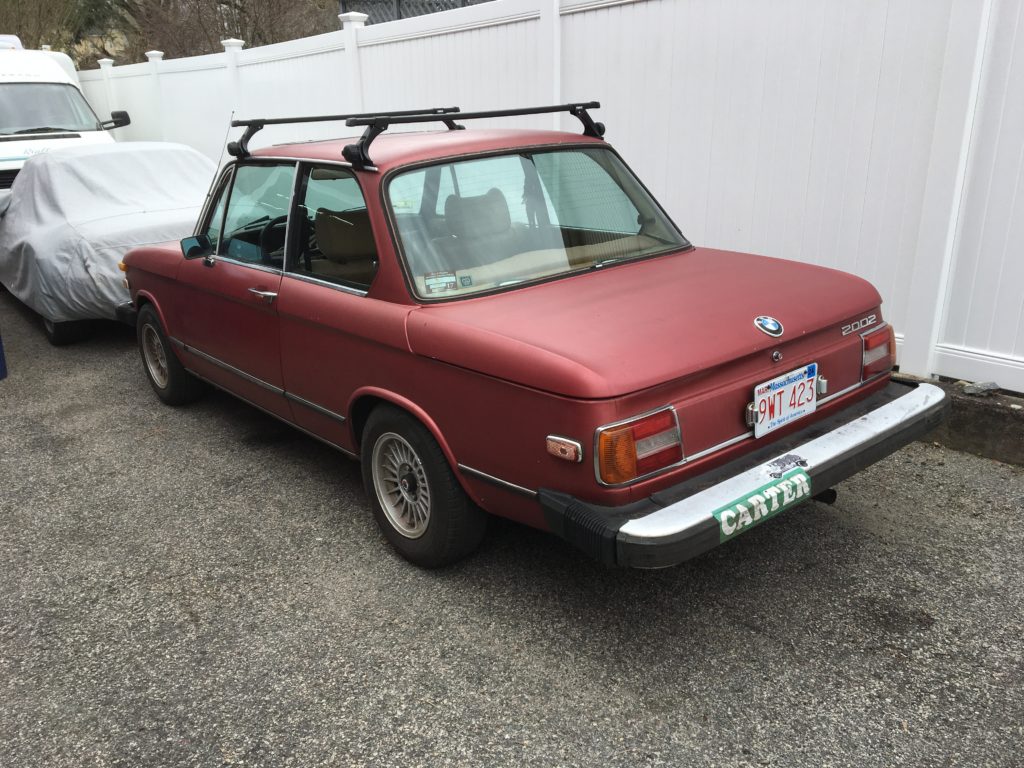
My post next week should be from MidAmerica 02Fest. Wish me luck.—Rob Siegel
Rob’s new book, The Best of The Hack Mechanic, is available here on Amazon, as are his seven other books. Signed copies can be ordered directly from Rob here.

